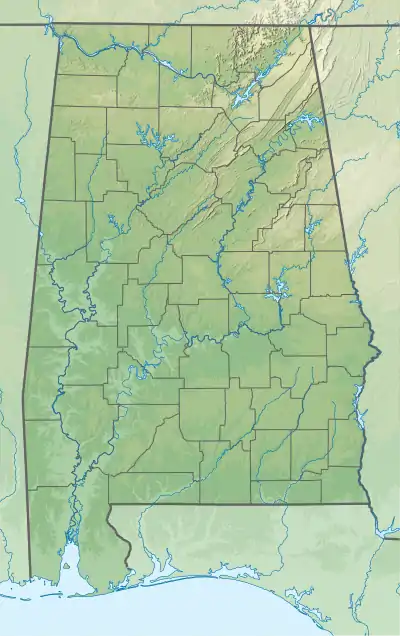Horseshoe Bend National Military Park
Horseshoe Bend National Military Park is a 2,040-acre, U.S. national military park managed by the National Park Service that is the site of the last battle of the Creek War on March 27, 1814. General Andrew Jackson's Tennessee militia, aided by the 39th U.S. Infantry Regiment and Cherokee and Lower Creek allies, won a decisive victory against the Upper Creek Red Stick Nation during the Battle of Horseshoe Bend at this site on the Tallapoosa River. Jackson's decisive victory at Horseshoe Bend broke the power of the Creek Nation.[3]
| Horseshoe Bend National Military Park | |
|---|---|
 | |
  | |
| Location | Tallapoosa County, Alabama, USA |
| Nearest city | Alexander City, Alabama |
| Coordinates | 32°58′15″N 85°44′18″W |
| Area | 2,040 acres (8.3 km2) |
| Established | July 25, 1956 |
| Visitors | 45,372 (in 2019)[1] |
| Governing body | National Park Service |
| Website | Horseshoe Bend National Historic Park |
Horseshoe Bend National Military Park | |
| Built | 1813 |
| NRHP reference No. | 66000060[2] |
| Added to NRHP | October 15, 1966 |
Over 800 Upper Creeks died defending their homeland. This was the largest loss of life for Native Americans in a single battle in the history of United States.[4]
On August 9, 1814, the Creeks signed the Treaty of Fort Jackson, which ceded 23 million acres (93,000 km2) of land in Alabama and Georgia to the United States government.

References
- "Annual Visitation Report by Years: 2009 to 2019". nps.gov. National Park Service.
- "National Register Information System". National Register of Historic Places. National Park Service. July 9, 2010.
- Scott, David (2004). Guide to the National Park Areas Eastern States. Guilford, Conn: Globe Pequot Press. p. 1. ISBN 0-7627-2988-0. OCLC 55075855.
- "Horseshoe Bend National Military Park". National Park Service. Retrieved March 1, 2008.